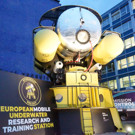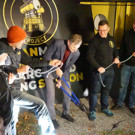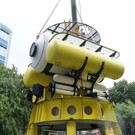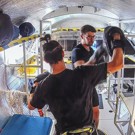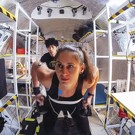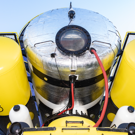The Czech Technical University (CTU) opened the first training center for the simulation of space missions. To investigate life in space, Czech scientists use the Hydronaut project, sponsored by the European Space Agency. The mission will help investigate the effect of being in space on the human body and psyche.
The Czech Hydronaut project, which consists, among other things, in the development and operation of the scientific underwater laboratory Hydronaut H03 DeepLab, is a unique undertaking even on a global scale. Its goal is to enable a versatile simulation of piloted space and other isolation missions, possibly also training of divers, rescuers, firefighters or speleologists. All this under precisely monitored and controlled scientific conditions and massive data collection. The laboratory is currently located in the CTU campus in Prague.
Hydronaut H03 DeepLab
Hydronaut DeepLab is a research and training station designed for short / long-term stays of small groups underwater and on the surface.
The station was designed for a wide spectrum of research, ranging from the impact of isolation and extreme environment on
human psychology to testing technology functioning under extreme conditions.
It enables on-demand simulated analog space missions in isolated, confined, and extreme environment (ICE):
- underwater, on the surface, hybrid
- including circadian rhythms shift
- communication delay
Main features:
- operational 24/7
- habitable volume and surface area app. 10 m3 / 10 m2
- environmental condition sensors
- artificial light: different day / light cycles possible
- daylight and infrared cameras for continuous monitoring
- inner habitat power supply: 12 V
- fully scalable: from a diving bell (empty habitat) to a fully equipped habitat within 24-hour window
Little Moon City Prague
At the end of August 2023, all the components of Hydronaut were transported from the flooded quarry in the village of Jesenný to the CTU campus in Prague's district, where they were reassembled. Over the next two years, they will serve here for the purposes of so-called dry missions, i.e., simulations of space missions outside aquatic environments.
The new location on dry land will allow participation in training and utilization by individuals without diving training,
especially benefiting local students in technical fields.
The combination of the Hydronaut H03 DeepLab, the Mission control center and the tent for possible EVA gave rise to the complex
facility of LMCP (Little Moon City Prague).
On November 14th 2023, LMCP was unveiled to the public at the ČVUT campus in Prague. The inaugural ceremony was attended by the experienced Italian astronaut and aerospace engineer, Paolo Nespoli, who has participated in three spaceflights, accumulating a total duration of over 313 days in space.
The environment inside the habitat
The team from the FME CTU in Prague, specifically from the Department of Fluid Mechanics and Thermodynamics, is responsible for the design and construction of equipment for online monitoring of the state of the atmosphere inside the habitat.
The unique device was designed for long-term monitoring of temperature, humidity and pressure, the composition of the atmosphere and the intensity or temperature of the lighting inside the Hydronaut. The device also monitors the on-board voltage and electrical power consumption of the habitat. All data is sent to the mission command center in real time.
The CTU team will also address the problem of high relative humidity inside the research facility. As already obtained data show, this is an environment with a relative humidity exceeding 95%, when the dew point temperature is around 17 °C. Practically, this means that water vapor condenses on all walls or objects with a temperature lower than 17 °C. This phenomenon brings with it a number of complications. The aim of the scientists will be to reduce the humidity inside the habitat, both by reducing its production and by applying one of the methods of controlled water vapor condensation.
Source: https://www.hydronaut.eu/en/
![[design/2014/cvut-logo-en-white.png]](https://www.fs.cvut.cz/content/images/design/2014/cvut-logo-en-white.png)
![[design/2014/cvut-logo-en-print.jpg]](https://www.fs.cvut.cz/content/images/design/2014/cvut-logo-en-print.jpg)


